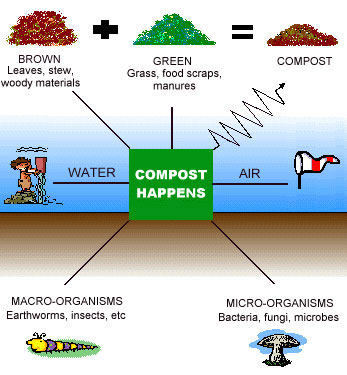Compost is easy to make. Essential composting ingredients include organic matter, water, air and nitrogen. Research indicates that soil or compost starters aren’t essential to successful composting, because organic matter naturally contains the necessary decomposing bacteria.
Oxygen and water are critical elements in the composting process. To speed decomposition, moisten materials as you place them in the compost bin. Keep compost moist, but not waterlogged.
Oxygen penetration is key to decomposition. Infiltration rates are a factor of particle size and bin size. For fine materials, a three foot by three foot by three foot bin works well. For coarser materials, like fall leaves, a bin five to six feet square allows rapid heating and faster processing.
Don’t finely chop or pack compost materials, because it restricts oxygen infiltration. If your compost smells obnoxious, it means the materials are packed too tight. To fix the problem, mix in coarser materials to allow better oxygen penetration.
Active compost reaches temperatures ranging from 70 to 130 degrees Fahrenheit in the center of the compost. Disease organisms die at 122 degrees Fahrenheit. Heating is essential, because it stimulates the bacterial process and helps keep the interior of the compost free from weed seed and plant-disease organisms. Some gardeners turn compost regularly to ensure that all materials are heat processed. Frequent turning speeds decomposition, but isn’t required to make compost.
In Colorado, it’s best not to turn compost after December. Turning allows valuable heat to escape, and may stop processing in cold weather. To restart active processing, turn and mix in fresh materials with the winter compost.
Processing occurs faster when materials are mixed together, rather than layered in the bin.
Compost is ready to use when it has shrunk to one-half its original volume, has lost the identity of the original material, and has a pleasant earthy smell.
For more information, see the following Planttalk Colorado™ video(s).
For more information, see the following Colorado State University Extension fact sheet(s).



